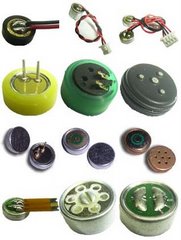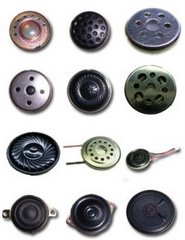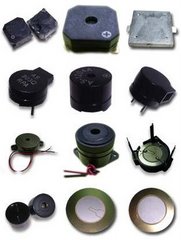The basic structure of the speaker and the receiver is almost the same; the diaphragm generates the sound by the reaction upon the sound coil and magnet.
The main diversities are as below:
The different usage Depend on the size of the speaker; the distance between the speaker and the user’s ears is normally from several dozens of centimeters to several meters. However we always nestle up a receiver against our ears.
The different material of the diaphragm and the sound coil In order to bear the higher power, the diaphragm of the speaker is usually thicker than the receiver, the thinnest one is 18u. The larger of the dimension and the power is the heavier the diaphragm will be. The receiver takes the lower power, but requests for better low frequency curve; therefore we usually use the diaphragm with the thickness from 6u-12u. Besides the diaphragm, the receiver often works with a piece of paper or cloth to adjust the frequency response, which can help to meet all kinds of standards or to match up the resonant box of the mechanism.
The different electronic characteristic We often see the speaker with impedance of 4-8ohm, the too high impedance leads to the higher power to drive the speaker, normally is from 0.2W to several dozens of watt. Depend on the circuit design, the impedance of the receiver is from 16, 32 to 150ohm. The general power is only from 0.01W to 0.1W.
喇叭(Speaker)與受話器(Receiver)的基本構造是大同小異的,都是透過音圈與磁鐵的作用力,帶動振動膜來發聲,
有幾點較大差異如下:
使用上的不同:
喇叭通常是離使用者的耳機有幾十公分甚至幾十公尺的距離,視喇叭的大小不同而定,
而受話器是緊貼著耳朵來使用的,
膜片,音圈等材質不同:
喇叭需承受較大的功率,故膜片厚度都較厚,從最薄的18u開始,尺寸愈大,功率愈大,膜片就會愈厚重,
受話器的功率小,但要求低頻曲線要好,故一般採用6u-12u的膜片,
除了膜片之外,受話器通常會加貼調音紙或調音布,來調整頻率響應,以符合各種的規範或是來配合機構的共嗚腔.
電氣特性上的不同:
喇叭最常見的為4-8ohm,太高的阻抗會使喇叭需要更高的電壓才能驅動,0.2W到幾十W都有
受話器從16,32,64ohm到150ohm都有,端看客戶的線路設計匹配,一般的功率只有0.01W到0.1W.
Blog of Buzzer, Condenser Microphone, Micro Speaker, We are manufacturer of acoustic components, SMD buzzer, piezo transducer, condenser microphone, rectangular speaker, speaker. BY Advanced Acoustic Technology Corp.
Acoustic Components Forum
Pls post any question about acousitc, acoustic components,
請在此提出有關聲學或電聲零件的問題.
Our Website
Condenser Microphone

Micro Speaker

Buzzers

Buzzers
網誌存檔
Profile
AATC was established in 1995, which is a leading manufacturer of high quality acoustic components (buzzer, micro-speaker, dual speaker, condenser microphone, and receiver, earphone). AATC has outstanding experience to supply high quality products for various applications. Our management and finished products meet the QS9000 & ISO9001, ISO 14000 standard, assuring you of the best quality.
苙翔科技成立於1995年,專業生產銷售高品質的電聲零件,如蜂鳴器,小喇叭,二合一喇叭,電容式麥克風,受話器,耳機..等,我們有多年的製造經驗,可提供高品質的產品及技術服務,所屬的工廠,已取得QS9000,ISO9001,ISO14000的認證,並已全面生產RoHS的產品.
